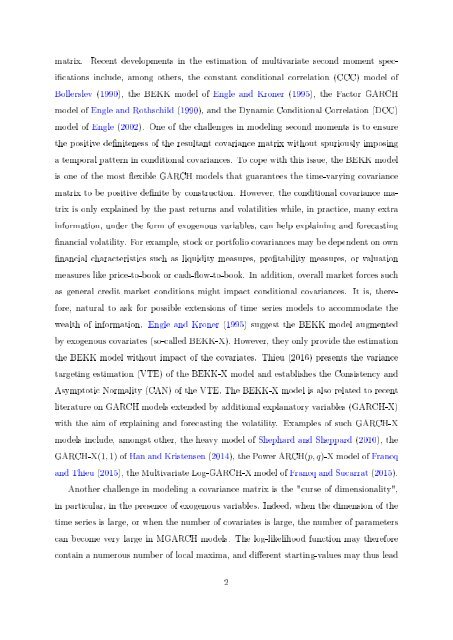MPRA
n?u=RePEc:pra:mprapa:75582&r=ets
n?u=RePEc:pra:mprapa:75582&r=ets
Create successful ePaper yourself
Turn your PDF publications into a flip-book with our unique Google optimized e-Paper software.
matrix. Recent developments in the estimation of multivariate second moment specications<br />
include, among others, the constant conditional correlation (CCC) model of<br />
Bollerslev (1990), the BEKK model of Engle and Kroner (1995), the Factor GARCH<br />
model of Engle and Rothschild (1990), and the Dynamic Conditional Correlation (DCC)<br />
model of Engle (2002). One of the challenges in modeling second moments is to ensure<br />
the positive deniteness of the resultant covariance matrix without spuriously imposing<br />
a temporal pattern in conditional covariances. To cope with this issue, the BEKK model<br />
is one of the most exible GARCH models that guarantees the time-varying covariance<br />
matrix to be positive denite by construction. However, the conditional covariance matrix<br />
is only explained by the past returns and volatilities while, in practice, many extra<br />
information, under the form of exogenous variables, can help explaining and forecasting<br />
nancial volatility. For example, stock or portfolio covariances may be dependent on own<br />
nancial characteristics such as liquidity measures, protability measures, or valuation<br />
measures like price-to-book or cash-ow-to-book. In addition, overall market forces such<br />
as general credit market conditions might impact conditional covariances. It is, therefore,<br />
natural to ask for possible extensions of time series models to accommodate the<br />
wealth of information. Engle and Kroner (1995) suggest the BEKK model augmented<br />
by exogenous covariates (so-called BEKK-X). However, they only provide the estimation<br />
the BEKK model without impact of the covariates. Thieu (2016) presents the variance<br />
targeting estimation (VTE) of the BEKK-X model and establishes the Consistency and<br />
Asymptotic Normality (CAN) of the VTE. The BEKK-X model is also related to recent<br />
literature on GARCH models extended by additional explanatory variables (GARCH-X)<br />
with the aim of explaining and forecasting the volatility. Examples of such GARCH-X<br />
models include, amongst other, the heavy model of Shephard and Sheppard (2010), the<br />
GARCH-X(1, 1) of Han and Kristensen (2014), the Power ARCH(p, q)-X model of Francq<br />
and Thieu (2015), the Multivariate Log-GARCH-X model of Francq and Sucarrat (2015).<br />
Another challenge in modeling a covariance matrix is the "curse of dimensionality",<br />
in particular, in the presence of exogenous variables. Indeed, when the dimension of the<br />
time series is large, or when the number of covariates is large, the number of parameters<br />
can become very large in MGARCH models. The log-likelihood function may therefore<br />
contain a numerous number of local maxima, and dierent starting-values may thus lead<br />
2




